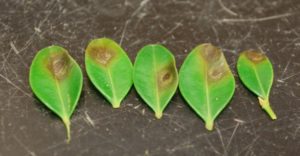It’s Time For Dormant Pruning
Deciduous trees and shrubs are plants that drop their leaves generally during autumn or winter, and enter a dormant state. This is done mainly to conserve water that the tree needs to survive. Leaves contain small pores called stomata that allow for gas exchange to occur between the tree and the surrounding atmosphere, a process that is necessary for photosynthesis. However, these stomata also allow for a large amount of water to escape from the tree. By dropping its leaves, a deciduous tree or shrub can limit the amount of water that escapes from the plant during winter, allowing it to survive.
Trees can benefit from tree care services all year round. Procedures done during winter can lead to a healthier tree come spring. For example, applying a wide and evenly spread layer of mulch around a deciduous tree in early winter can help that tree bloom earlier and grow faster in spring. The layer of mulch acts as an insulator to the soil and roots of the tree, which remain active even in the winter. This extra layer of insulation reduces dramatic temperature changes in the soil, which can be harmful to roots.
Winter months also give arborists and tree care professionals a window of opportunity to perform dormant pruning. As the name suggests, dormant pruning is trimming that occurs during autumn or winter months (November – March), when deciduous trees are in their dormant state. With no leaves on the tree, arborists can easily examine the shape, structure, and condition of the tree’s branches. Contrary to what most homeowners think, dead wood is actually much easier to spot during winter. With no leaves to get in the way, dead wood can be easily spotted by changes in branch color, any cracks on the branch, fungus growth, or other symptoms such as the presence of buds. Once dead wood is identified it can be easily removed making the tree healthier and the property safer.
Not only does dormant pruning allow for easy identification of dead wood, it also allows for the overall structure of the tree to be examined. Professional pruning is more than the simple act of cutting out dead wood. Good tree care professionals shape the tree with pruning, providing long term health benefits. For example, if left alone or not pruned properly, trees can grow crossing branches in its crown. These crossing branches compete for the same space and resources in the crown, and by removing them a tree care profesional can increase both air flow and sunlight exposure to the crown as a whole. Proper dormant pruning can also improve the overall appearance and structural integrity of the tree.
Different styles and techniques of dormant pruning should be used depending on the condition of tree or shrub and the desired effect of the trimming. There are three main types of dormant pruning for trees and shrubs: selective pruning, renewal pruning, and rejuvination pruning. Selective pruning is the method most commonly used on trees. It is used to control the size and shape of the tree, as well as remove dead wood. First, obvious dead wood is removed. From there on, pruning is done branch by branch, removing branches that are not in healthy condition, or present a strucutral problem to the tree. Branches in trees should be removed at their base points, where they branch off from the trunk or another branch. If the branch is large or heavy enough, a 3-cut method should be used to avoid any bark from being torn away with the branch. This method works by first making an upward cut about 1 or 2 feet away from the base of the branch. A downward cut is then performed, again 1-2 feet away from the base, intersecting with the first cut, effectively leaving a 1-2 foot branch stump, alleviating most of the weight of the branch. The final top-down cut can then be performed on the branch stump with no fear of torn bark or further damage to the tree. When conducting selective pruning, especially on shrubs, it is important to take breaks and step back from the plant, evaluating the effects of the pruning taking place, and when to stop.
Renewal pruning is performed most commonly on shrubs. Old shrubs with large branches and old growth can quickly become thickly overgrown, looking gnarly and unshaped. The goal of renewal pruning is to eliminate this old growth over time, and replace it with new growth. This is done in stages by cutting the oldest, most overgrown branches down to the ground, removing no more than a third of the plant at a time. In spring, new branches will grow to replace that third. Over a period of three years, removing a third of the old growth down to the ground each year, all of the old growth will be removed, and replaced (or renewed) with new, healthy growth.
Rejuvenation pruning is a drastic measure used only when a shrub is vastly overgrown or dense. In early winter the shrub is cut back entirely, to within an inch or two to the ground. The result may be surprising, but in spring new growth should begin to grow back, and within a few years the shrub will recover with new vigor. It should be noted that this method of pruning should be done only by professionals or after consultation by a professional, as not all decidous shrubs can survive the process, and the ideal timing of the pruning varies between species.
Boxwood blight confirmed in Illinois
URBANA, Ill. – Boxwood blight, a serious fungal disease, has been confirmed in Illinois. According to a University Diagnostic Outreach Extension Specialist, two boxwood samples were submitted to the University of Illinois Plant Clinic in late 2016. The samples came from Lake and Cook Counties in northeastern Illinois. Both were from recent landscape additions.
Although the characteristic leaf spots were not apparent on the samples, defoliation and stem cankers were noted,
— Diane Plewa
Stem cankers are easiest to see on new, green stem tissue. The cankers are dark brown or black, and are often linear or diamond-shaped.

Bissonnette adds that boxwood blight was formerly federally regulated, but is now regulated at the state level. “Although it can cause widespread death of hosts in the environment, the spores of the pathogen do not appear to travel extensively, reducing its overall impact. However, in production facilities where equipment can be contaminated and expose hundreds or thousands of plants, the pathogen is a much larger concern.”
The pathogen was identified for the first time in the United States in 2011, and has since been found in 18 states. Most are located in the eastern part of the country, though confirmations have been made in Missouri and Ohio.
News Sources: Diane Plewa, 217-333-0519, Suzanne Bissonnette
News Writer: Debra Levey Larson, 217-244-2880
Image Sources: Adobe Stock & Rutgers Plant and Pest Advisory – Rutgers University
Tree Pruning to Ansi Standards
Follow the link below to read about the Tree Care Industry Associations recommendations for tree pruning based on the ANSI Standards.
- « Previous
- 1
- 2
- 3

